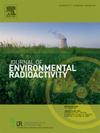Geant4 对人类暴露于建筑材料产生的室内 222Rn 的蒙特卡罗模拟。
IF 1.9
3区 环境科学与生态学
Q3 ENVIRONMENTAL SCIENCES
引用次数: 0
摘要
本研究旨在开发一种蒙特卡洛模型,以估算由于标准模型房间墙壁和地板中的氡气引起的氡照射的年有效剂量。为了开发一种用于评估住宅和工作场所氡水平的工具,研究人员使用 Geant4 工具包模拟了放射性氡子体在模型室内三个不同位置的水模型中发射的伽马射线所沉积的能量。然后通过确定性方法利用能量沉积来估算每年的有效剂量。模拟结果与实验数据显示出良好的一致性,模拟数据与实验数据之间的比值显示高估了约 1.09 倍。模拟数据和实验数据在同一范围内,相对偏差为 7.7%。此外,还评估了各种参数对房间内氡吸入年有效剂量的影响,如受体在房间内的位置、墙壁和地板厚度、墙面覆盖率和建筑材料体积密度。事实证明,Geant4 蒙特卡洛工具包是在实际暴露情况下进行氡建模的可靠工具。本文章由计算机程序翻译,如有差异,请以英文原文为准。
Geant4 Monte Carlo simulation of human exposure to indoor 222Rn from building materials
The present study aimed to develop a Monte Carlo model to estimate the annual effective dose due to radon exposure sourced by radon gas in the walls and floor of a standard model room. With the purpose of developing a tool for radon level assessment in dwellings and workplaces, Geant4 toolkit was used to simulate the energy deposited by gamma rays emitted by radioactive radon progeny in a water phantom positioned at three different locations within the model room. The energy deposition was then used to estimate the annual effective dose through a deterministic approach. The simulation outcomes showed good agreement with experimental data, with the ratio between the simulated and the experimental data displaying the overestimation by a factor of approximately 1.09. Both simulation and experimental data fell within the same range, with a relative deviation of 7.7%. Additionally, the influence of various parameters, such as receptor position in the room, wall, and floor thicknesses, wall cover, and building material bulk density, on the annual effective dose due to radon inhalation in the room was evaluated. Geant4 Monte Carlo toolkit proved to be a reliable tool for radon modeling in real exposure situations.
求助全文
通过发布文献求助,成功后即可免费获取论文全文。
去求助
来源期刊

Journal of environmental radioactivity
环境科学-环境科学
CiteScore
4.70
自引率
13.00%
发文量
209
审稿时长
73 days
期刊介绍:
The Journal of Environmental Radioactivity provides a coherent international forum for publication of original research or review papers on any aspect of the occurrence of radioactivity in natural systems.
Relevant subject areas range from applications of environmental radionuclides as mechanistic or timescale tracers of natural processes to assessments of the radioecological or radiological effects of ambient radioactivity. Papers deal with naturally occurring nuclides or with those created and released by man through nuclear weapons manufacture and testing, energy production, fuel-cycle technology, etc. Reports on radioactivity in the oceans, sediments, rivers, lakes, groundwaters, soils, atmosphere and all divisions of the biosphere are welcomed, but these should not simply be of a monitoring nature unless the data are particularly innovative.
 求助内容:
求助内容: 应助结果提醒方式:
应助结果提醒方式:


